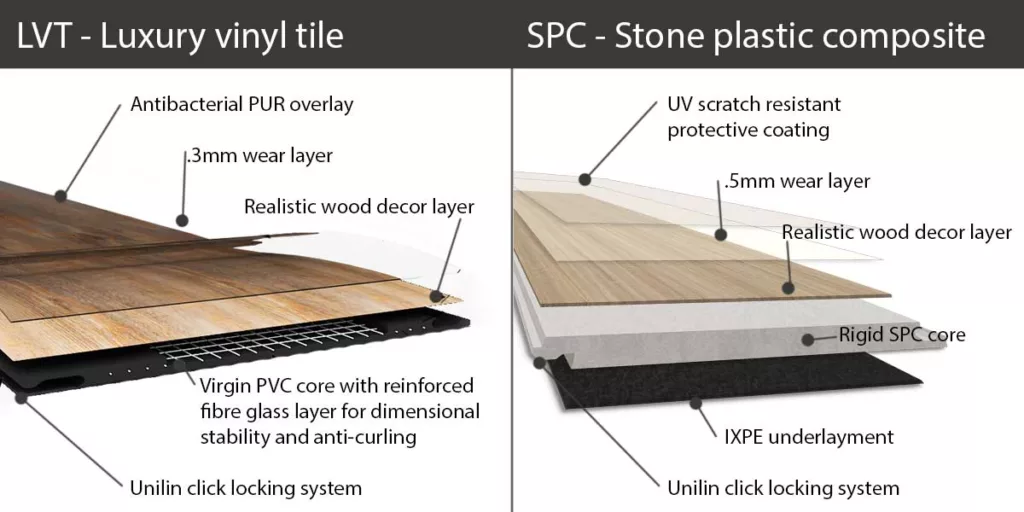In modern interior design, the choice of flooring plays a pivotal role in shaping a space’s overall aesthetics, functionality, and durability. Stone Plastic Composite (SPC) and Luxury Vinyl Tile (LVT) flooring are two popular options that have gained significant traction in recent years. These innovative flooring solutions offer a range of benefits. Still, it is crucial for homeowners, designers, and builders alike to grasp their advantages and disadvantages to make informed decisions for their projects.

source: we8international.com
SPC and LVT flooring are part of the vinyl flooring family and share similarities. Luxury Vinyl Tile (LVT) consists of multiple vinyl and photographic layers that replicate the appearance of various materials such as wood, stone, or ceramic. It provides a cost-effective alternative to natural materials without compromising on aesthetics. On the other hand, Stone Plastic Composite (SPC) flooring is a recent innovation combining limestone powder, polyvinyl chloride (PVC), and stabilizers to create a rigid core that mimics the look and feel of stone or wood.
With any flooring selection, it is imperative to have a comprehensive understanding of its advantages and disadvantages. This knowledge empowers homeowners and professionals to make educated decisions based on their unique requirements, budget, and long-term goals.
Advantages of SPC Flooring
When considering flooring options, Stone Plastic Composite (SPC) flooring boasts several advantages that make it a popular choice among homeowners and designers.
- SPC flooring is highly resistant to scratches, dents, and impacts, ensuring it maintains its pristine appearance even in high-traffic areas such as hallways, entryways, and living spaces.
- Cost-Effectiveness: Another advantage of SPC flooring is its affordability compared to other options like Luxury Vinyl Tile (LVT). Due to not needing as much synthetic PVC component per piece for manufacturing, as it combines the composition with naturally occuring limestone powder, the psf rates of SPC vinyl flooring tend to be usually cheaper.
Disadvantages of SPC Flooring
While Stone Plastic Composite (SPC) flooring offers numerous advantages, it is important to consider its potential disadvantages.
- Sensitivity to Temperature Fluctuations: One notable disadvantage of SPC flooring is its sensitivity to temperature changes. Due to its rigid core composition, SPC flooring may expand or contract in response to extreme temperature variations.
- Requirement for a Certain Level of Floor Evenness: SPC flooring demands a relatively higher evenness of subfloor for installation. The rigidity of SPC planks or tiles means that any irregularities or imperfections in the subfloor can transfer through the flooring, compromising joints over a shorter period due to its inflexibility. This may cause very sharp edges to pop out even after a duration of 1 year from installation.
- Challenges in Repair: Another factor to consider is the difficulty in repairing SPC flooring. Unlike other flooring options, such as hardwood or carpet, which can be individually replaced or repaired, SPC flooring generally requires removing and replacing an entire portion of planks or tile if damage occurs. Alternatively, the replacement piece needs to be majorly tweaked and have its auto click system clipped in order to refit it into a centerpiece.
- Requirement for Foam: due to its rigidity, foam underlayment is often recommended during the installation of SPC flooring. This foam layer reduces formation of cracks upon impact due to its rigidity.You can check this video about SPC vinyl flooring joints dislodging in a house that had installed SPC flooring just about a year ago.
- Sold as a thicker product: Its thickness is usually sold by vendors as including the thickness of the foam. So for example if a SPC product is actually 5mm, but comes with 2.5mm of foam layer, then it is sold in the market as a “supposedly superior” 7.5mm product. The customer may be unknowingly paying significantly extra for a product that is actually just the same as the typical 5mm in the market.
- Foam undermines integrity of joints: While the foam is a requirement for SPC flooring due to its more fragile and rigid nature, at the same time, it undermines the integrity of the autoclick joints. The thickness of the foam allows for compression of foam at the joints, causing the joints to be pressed in and out upon stepping. Continuous stepping of the joints over the foam over time results in possible dislodgement of the joints for SPC vinyl flooring. This is why there are many complaints of SPC vinyl flooring joints being dislodged over the past few years.
Advantages of LVT Flooring:
Luxury Vinyl Tile (LVT) flooring has gained immense popularity in recent years thanks to its numerous advantages. Let’s explore four key benefits: versatility in design and aesthetics, durability, comprehensive installation options, and enhanced comfort and noise reduction.
- Versatility in Design and Aesthetics: LVT flooring offers exceptional versatility in design and aesthetics. It can replicate the look and texture of various natural materials such as hardwood, stone, or ceramic tiles, allowing homeowners and designers to achieve their desired aesthetic without natural materials’ associated costs and maintenance requirements. LVT flooring provides a wide range of colors, patterns, and finishes, allowing customization and flexibility in matching different interior styles and preferences.
- Durability and Resistance: LVT flooring is renowned for its durability, making it an ideal choice for high-traffic areas in both residential and commercial spaces. The wear layer on the surface of LVT flooring provides excellent resistance against scratches, stains, and fading caused by sunlight or exposure to chemicals. This robust construction ensures that the flooring maintains its original appearance and withstands the rigors of daily use, making it a long-lasting investment for any space.
- Wide Range of Installation Options and Subfloor Compatibility: Another advantage of LVT flooring is its versatility in installation options. LVT is available in various formats, including planks and tiles, which can be easily installed using different methods such as glue-down, click-lock, or loose-lay installation. This flexibility enables homeowners and professionals to choose the most suitable installation method based on the specific requirements of their project.
You may also like: 10 Reasons Why Vinyl Flooring Is a Great Choice For Your Home
Disadvantages of LVT Flooring:
While Luxury Vinyl Tile (LVT) flooring offers numerous advantages, it is important to consider its potential drawbacks. Let’s explore three key disadvantages: higher initial cost compared to SPC flooring, sensitivity to direct sunlight and UV exposure, and concerns regarding its eco-friendliness.
- Higher Initial Cost Compared to SPC Flooring: One of the primary disadvantages of LVT flooring is its higher initial cost compared to Stone Polymer Composite (SPC) flooring. LVT typically requires more synthetic materials in its production, including multiple layers and additional surface treatments, which can contribute to its higher price point. However, it is important to note that the cost of LVT can vary depending on the quality, brand, and specific design chosen.
- Sensitivity to Direct Sunlight and UV Exposure: LVT flooring, particularly lower-quality or older versions, may be susceptible to fading or discoloration when exposed to direct sunlight or prolonged UV exposure. Over time, the vibrant colors or patterns of LVT flooring may fade or lose their original luster. To mitigate this disadvantage, it is recommended to utilize window treatments or protective coatings that minimize the amount of UV radiation reaching the flooring. Additionally, selecting LVT products with UV-resistant properties can help prolong their lifespan and maintain their aesthetic appeal.
In Home Expo Asia we always try our best to provide the best vinyl flooring for our customers. That’s why our vinyl flooring products are certified by FloorScore, Green Label Singapore, and CE marking as proof that our vinyl flooring is safe and eco-friendly.
You may also like:List of 11 Best Vinyl Flooring Companies in Singapore [Updated 2023]
Conclusion
Both Stone Polymer Composite (SPC) and Luxury Vinyl Tile (LVT) flooring offer a range of advantages and disadvantages that should be carefully considered when choosing the right flooring option. SPC flooring excels in durability and resilience, often at a more affordable price than LVT flooring. Still, one thing that should be considered is the rigid factor of SPC because you will need some certainty of evenness of the floor to make sure SPC can install properly and prevents dislodging of joints. On the other hand, LVT flooring provides versatility in design and aesthetics, along with superior comfort and noise reduction. However, LVT flooring has a higher initial cost, sensitivity to sunlight and UV exposure, and potential environmental concerns.
It is important that you understand that it is not necessarily the case that foam means better, and without foam means not good. Or that rigid core means a more solid and stable product. While SPC is a newer “version” of vinyl flooring, it is not necessarily better. In fact, it has not stood the test of time, whereas LVT has been in the market for at least 10 years. Even suppliers are starting to stop their supply of SPC products due to the liability issues with the joints.
